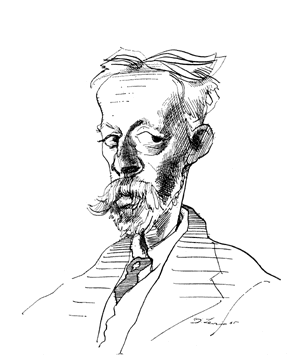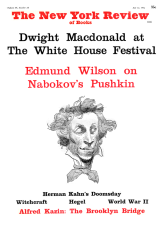Roger Lhombreaud disappoints the hope that this first biography of Symons might obviate the need for another. He is straightforward and affable, but Symons was affable too, and more rigor is required in his biographer. M. Lhombreaud has worked on Symons for over ten years, and he is the first to take advantage of the many unpublished papers and letters now scattered among several libraries. He sometimes summarizes these but rarely quotes from them, though his book would profit from detailed-evidence. Instead he prefers to quote at length from formal reminiscences of Symons by other writers; while correcting factual errors he fails to offer sufficient comment to bring this material within his own perspective. When problems of interpretation appear, as with Symons’s insanity or his possible obsession with evil, M. Lhombreaud offers a few psychiatric words and otherwise declines responsibility for analysis. In four long and loosely organized chapters which make up the book, he moves uncertainly from topic to topic, underplaying his hand.
Symons deserves more incisive treatment. Not a great writer, as M. Lhombreaud concedes, he was a useful and in many ways attractive one. As a young Cornishman, privately educated and precocious, he descended upon London resolved to make the metropolis aware of him. Soon he was more cosmopolitan than anybody. At a strategic moment, when Villiers, Verlaine, Mallarmé, and others were in their last years, he took to frequenting the continent, Paris above all, and to bringing back sad, bad, mad news of that brilliant and dissolute world.
Some elements of his behavior might have been predicted. That the son of a Methodist preacher should hate all clergymen is standard, of course, and the juvenile poems about Judas, Cain, and opium eating are necessary corollaries. But Symons offers a subtler confusion of would-be profligacy and innocence. He dazzled Yeats by his procession of loves, from ballet dancers to serpent-charmers. Yet he seems to have wished to suffer for his studied sinfulness by having these women reject or forsake him, and all the time he longed for a love as hopeless as Yeats’s. This was almost vouchsafed him, M. Lhombreaud indicates, by the woman who kept him waiting interminably until she decided he was worth marrying. Meanwhile Symons as a writer prided himself on poems like “Stella Maris,” where he referred to “the Juliet of a night.” It was, as he told Paul Verlaine, “un peu osé” for an English review. He was always hoping to sound as sinful as Baudelaire. But when challenged in moral terms he retreated by suggesting that the poems pictured his moods rather than his doings, a possibility with which M. Lhombreaud is inclined to agree.
Symons did in fact take up bad habits with the utmost moderation. Yeats’s example, cited here, is the best: when he and Symons shared rooms in Fountain Court, The Temple, in 1895-96, they tried for a month drinking two glasses of whisky every night before retiring, to find out if addiction might result. Lamentably it didn’t, and after the month was over they returned to the beverage both preferred, hot water.
Precisely this quality in Symons encouraged the success of his principal book, The Symbolist Movement in Literature (1899). For in it he examined the bizarre lives of French authors with a kind of Cornish wonder. He was openly fascinated by Nerval’s madness, Verlaine’s sexual deviations, Mallarmé’s hermetic talk. All belonged to a world totally un-English through which Symons, upright yet faintly compromised, guided his English readers. He was the Vergil of this literary underworld. There is an element of snobbery, too. At a time when someone was desperately needed to drop French names, he dropped them gladly. He liked to regale his friends, among whom were members of high society, with tales of his low associations. Yet the interest was genuine, and he did bring English and American writers closer to French ones than at any time since, say, Swinburne took fire from Hugo.
Yet the book on symbolism, which M. Lhombreaud inexplicably declines to consider in detail, shies away from definition of the movement, Symons being content to offer various ways of vaguely looking at it. He lacked the capacity for synthesis which made Edmund Wilson’s Axel’s Castle, on the later phases of the same movement, a better book. Symons turned his defect as a critic into the “principle” that the writer can only hope to incur and impart “sensations and impressions.” Deft as he was with these, even in the Nineties not everyone found this principle satisfying. M. Lhombreaud describes a dinner party where Symons spoke in behalf of a nomadic life for the artist on the ground that sensations and impressions were more abundant away from home. Yeats boomed from across the table that an artist “worked best among his own folk and in the land of his fathers,” and Symons was temporarily silenced. In more considered statements about Symons, Yeats always praised his capacity for friendship; he was, it appears, a marvelous listener. But Yeats chided him for being too formless. Yeats was always solidifying what Symons somehow liquefied.
Advertisement
Symons has always been considered a man of the Nineties, but M. Lhombreaud offers the view that he ought to be regarded as apart from that period. It is hard to see why. Like other young men then, he formed his prose style on Pater’s and much of his philosophy; in fact, when Symons first came to London, he seems to have taken Pater rather too literally as a kind of father. Symons’s poetry also belongs to that time. It is most successful when, following Verlaine, it tries to capture an elusive, nostalgic moment. But the language is apt to fall into bad Yeats:
O white birds crying to me
The cry of my heart evermore…
or even bad Masefield, as in the passage which M. Lhombreaud calls “not unworthy of Walt Whitman”:
Give me a long white road, and the grey white path of the sea,
And the wind’s will and the bird’s will, and the heartache still in me…
For the failure of Symons was that so few of the impressions which he zealously pursued were exclusively his own.
In 1901 Symons married, and largely gave up his role of middleman between two cultures. He spoke grandly of making an esthetic of all the arts, and he dismissed symbolism and all other movements as inconsequential in this larger scheme. But he was not equal to his new task, or to the new century. A line which sounded in the Nineties so memorable, “My life is like a music hall,” was quickly dated. Before he could come to terms with the new literary situation, he fell into a manic depressive state which lasted from 1908 for about three years. Then he recovered his health but not his literary position. In later life he wrote his Confessions, where he sought to compare his madness with Nerval’s; he continued to write verse and to term it Baudelairean; but in spite of his effort to keep the senses disarranged in the way of the Nineties, he was painfully sane. Born like Yeats a hundred years ago, he survived until 1945.
This Issue
July 15, 1965




